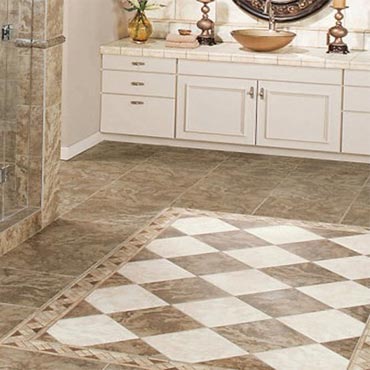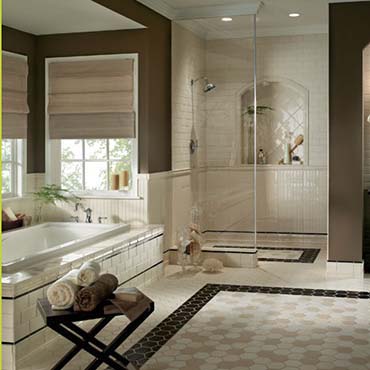As the first tile manufacturer in Tennessee (est. 1986), Crossville is the leading American manufacturer of beautiful, sustainable solutions that advance the frontiers of tile design. From introducing the nation’s first large-format porcelain tiles, to becoming the first and only net consumer of tile waste materials (meaning we recycle even more than we produce), to developing cutting-edge performance innovations that turn mere surfaces into “breathing” living environments—we are committed to pioneering products and practices that change the way the world views tile. Learn More
Floor Tile
Floor Tile Guide

The Enduring Elegance of Tile Flooring: A Timeless Choice for Modern Spaces
Tile flooring, a mainstay in architectural and interior design, has evolved remarkably over centuries, adapting to various styles and technologies while maintaining its essential charm. Its historical significance is profound, with ancient civilizations like the Romans and Egyptians showcasing exquisite tile work. Today, this flooring option has metamorphosed into a versatile and sustainable choice for contemporary design.
Defining Tile in Modern Flooring
Tile, in the context of flooring, refers to a manufactured piece of hard-wearing material such as ceramic, stone, metal, or even glass. Used primarily for covering roofs, floors, walls, or other objects, tiles are known for their durability and aesthetic appeal.
Material Properties and Sustainability
One of the most lauded properties of tile flooring is its durability and resistance to wear and tear. This characteristic makes it an ideal choice for areas with high foot traffic. Furthermore, its low maintenance requirements appeal to facility managers looking for cost-effective and long-lasting flooring options. From an environmental perspective, the energy-efficient production processes of tiles, alongside their recyclability, underscore a commitment to eco-friendly building practices.
Design Versatility and Aesthetics
The design versatility of tile flooring is unparalleled. Available in an array of colors, patterns, sizes, and finishes, tiles offer architects and designers a playground of possibilities. This versatility seamlessly aligns with various architectural styles, from minimalist modern to richly ornate, allowing for unique design solutions that can be tailored to any project.
Technical Advancements in Tile Flooring
Recent technological innovations in tile manufacturing have opened up new realms of customizability and design. Digital printing techniques, for instance, allow for intricate designs and realistic textures, such as wood grain or stone, on tiles. These advancements not only enhance aesthetic appeal but also expand the application possibilities of tile flooring.
Application Diversity in Architecture and Design
Tiles are not confined to residential spaces; they are equally prominent in commercial and healthcare facilities due to their functional benefits. The use of tile flooring in such diverse applications can be illustrated through various innovative projects, showcasing how they meet both aesthetic and functional requirements.
Performance and Functionality
In terms of performance, tile flooring excels in areas like water resistance and hygiene, with certain tiles offering antibacterial properties. This makes them ideal for environments where cleanliness and durability are paramount, such as healthcare facilities, commercial kitchens, and bathrooms.
Sustainability and Environmental Impact
Tiles contribute significantly to sustainable building practices. Many tile products are integral in achieving LEED certification and meet various environmental standards. The production and usage of tiles, keeping in mind environmental and health aspects, have become crucial factors in modern building specifications.
Cultural and Artistic Significance
The cultural importance of tile flooring cannot be overstated. Different regions around the world have distinct tile styles, reflecting their artistic heritage. Contemporary designers are increasingly using tiles to blend traditional motifs with modern design, creating spaces that are culturally rich yet contemporarily relevant.
Cost-Effectiveness and Long-Term Value
While tile flooring may present a higher upfront cost compared to some other materials, its long-term value lies in its durability and timeless appeal. When compared to other flooring options, tiles often emerge as a more advantageous choice, particularly in spaces where longevity and aesthetic value are priorities.
Conclusion: Paving the Future with Tiles
Tile flooring, with its blend of aesthetic flexibility, technical innovation, and sustainable properties, plays a pivotal role in shaping future trends in architecture and interior design. It offers a unique combination of practicality and artistic expression, making it an ideal choice for architects, interior designers, and facility managers. As we look towards a future where both form and function are paramount, the innovative potential of tile flooring stands as a testament to its enduring relevance in the design world.
Disclaimer: The information provided in this article is for general informational purposes only. While we strive to ensure the accuracy and reliability of the information presented, we make no warranties, express or implied, about the completeness, accuracy, reliability, suitability, or availability with respect to the content. Any reliance you place on such information is strictly at your own risk. We recommend consulting with professionals for specific advice tailored to your project’s needs, particularly regarding building codes, regulations, and product specifications.
Under no circumstances shall we be liable for any loss or damage, including without limitation, indirect or consequential loss or damage, arising from the use of, or reliance on, the information provided in this article.
Select Product Sub-Category:
Floor Tile
Top 5 Types of Floor Tile
 Ceramic/Porcelain - 85 Porcelain Tile FlooringPorcelain stoneware can be used instead of natural stone. It is a ceramic material like a tile; however, it is typically 20 mm (0.79 in) thick and often comes in squares of 60 cm (24 in). | |
 Ceramic/Porcelain - 79 Kitchen TileTransform your kitchen with our exquisite Kitchen Tile collection. Elevate your space with timeless elegance. Shop now and upgrade your home today! | |
 Ceramic/Porcelain - 87 Bathroom TileTransform your bathroom into a serene oasis with our exquisite Bathroom Tiles. Choose from a variety of elegant designs and durable materials. Elevate your space today! | |
 Ceramic/Porcelain - 78 Floor Tile (glazed)Introducing our Glazed Floor Tiles - a perfect blend of sophistication and durability. Elevate your space with these exquisite tiles today! | |
 Ceramic/Porcelain - 487 Floor Tile (unglazed)
Introducing our unglazed Floor Tiles, the perfect canvas for your creative vision. Craft stunning, unique floors that match your imagination. Transform your space today with these versatile tiles. Order now and start your flooring project! |
Featured Brands
The Best 3 Floor Tile Brands

Crossville Porcelain Tile
Profile | Website | Design Tools | Warranty | Install | Maintain | FAQs | GreenAs the first tile manufacturer in Tennessee (est. 1986), Crossville is the leading American manufacturer of beautiful, sustainable solutions that advance the frontiers of tile design. From introducing the nation’s first large-format porcelain tiles, to becoming the first and only net consumer of tile waste materials (meaning we recycle even more than we produce), to developing cutting-edge performance innovations that turn mere surfaces into “breathing” living environments—we are committed to pioneering products and practices that change the way the world views tile. Learn More

Floors 2000 Porcelain
Profile | WebsiteFloors 2000 is a ceramic tile distributor/ importer in Pensacola Florida. All products are first quality and we maintain a 98% in stock position. We look forward to serving your ceramic and porcelain tile needs. Learn More

Mid-America Tile
Profile | WebsiteEstablished in 1961, Mid America Tile is a wholesale tile distributor and importer specializing in all materials and styles, including ceramic, porcelain, glass, metal, and natural stone tile. Learn More
Floor Tile News
Latest Floor Tile News
Enlite Porcelain Tile...sing of time, Enlite™ embraces the calming effect of organic, natural stone visuals in a harmonious color palette. Enlite™ celebrates the belief that less is more with the simple offer of a new 15x30 floor tile and a random linear mosaic. EMBRACING HARMONYAwaken the soul with tranquil designNatural stone visuals in five calming colors MINIMALIST POSSIBILI... |
Prism: between colors and materials...domestic colors or architectural colors.” The rich range of sizes allows you to employ the resin effect in any interior design, covering walls and floors, with all the advantages of porcelain floor tiles and the beauty of white body wall tiles. ... |
4 Tips for Using Tile Sizes to Your Advantage...Nowadays, floor tile is available in many designs, styles, and sizes. From one-inch mosaics to large format planks, there are tons of tile options to fit your needs for any size room. Choosing tile that adds dimension, uniqueness or pops of color can be fun when you know how to blend different shapes and sizes to meet your design goals. Consider these following tips when selecting different til... |
3 Outdoor Living Space Remodel Ideas to Create a Sleek Modern Style...utiful stone patio floor. American Olean's Slate Collection has a variety of shades and size options. This series is a great example of how natural stone tile can offer the beauty of high-end floor tile and possess the strength and durability needed for outdoor conditions. Consider Large Tiles Patio areas and exterior spaces can exceed several hundred squar... |
Floor Tile (glazed)...The Ultimate Guide to Glazed Floor Tile for Business Owners, Property Managers, and Facility Managers IntroductionIn today's fast-paced business environment, selecting the right flooring is a decision that impacts aesthetics, functionality, safety, and cost-efficiency. Glazed Floor Tile stands out as an ideal solution for business owners, property managers, and facility m... |
Mosaic Tile...in Mesopotamia, these tiny, durable pieces have graced spaces from ancient Greek homes to modern high-rises, showcasing an unending allure in home decoration and design. In the Context of Floor Tile: Defining MosaicMosaic tiles, particularly when used as floor tiles, are more than just decorative elements; they are symphonies of small, often colorful, pieces of glass, stone,... |
Terra Cotta Floor Tile...Terra Cotta Floor Tile: A Timeless Choice for Modern Design Terra Cotta, an enduring material in the realm of floor tiles, has seamlessly transitioned from its historical roots to a staple in contemporary home decor and interior design. Its journey from ancient building material to a cherished element in modern homes is a testament to its timeless appeal. Historical... |
Floor Tile (unglazed)...Tile Timelessness: The Unvarnished Charm of Unglazed Floor Tiles in Modern Design Tiles have been a cornerstone in the world of design and decoration, tracing back to ancient civilizations. They started as functional elements in buildings but quickly evolved into decorative masterpieces, adorning palaces, temples, and homes. Today, unglazed floor tiles represent a blend of this... |
Mosaic Tile (unglazed)...ure and color of the clay visible, has been a timeless choice for designers and architects, lending authenticity and character to various settings. Defining the Unglazed: A Closer Look at Floor TilesIn the realm of floor tiles, 'unglazed' refers to tiles that have not undergone an additional firing process with a ceramic glaze. This results in a more natural, matte finish th... |
Silk-Screened Floor Tiles...The Timeless Elegance of Silk-Screened Tiles: Revolutionizing Modern Interior Spaces Introduction to Silk-Screened TilesThe journey of tiles in home decoration and design is a tapestry woven through history. Originating as practical solutions for waterproofing in ancient civilizations, tiles have evolved into pivotal design elements. Today, they stand at the fore... |
Floor Tile...Tiles Through Time: The Evolution and Revolution of Floor Tiles in Modern Design The Journey from Ancient Floors to Modern SpacesThe history of floor tiles is a tapestry woven through time, from ancient Egyptian pyramids to the gleaming floors of modern high-rises. Originating as functional elements, these tiles have transcended their utilitarian roots to become ... |
Historical Tiles...ilities. Design Flexibility: Marrying the Old with the NewThese tiles are not just for period homes; they can complement a range of design themes. Imagine a Victorian patterned floor tile bringing warmth to a modern minimalist kitchen, or Turkish Iznik tiles adding a splash of color to a contemporary bathroom. Historical tiles provide a unique opportunity to meld different d... |
Earthen Floor...Beneath Your Feet: The Timeless Charm of Earthen Floor Tiles in Modern Design Introduction to Earthen Floor TilesThe story of Earthen Floor Tiles begins in the cradle of ancient civilizations, where they served as a fundamental element in building the earliest homes. Evolving through centuries, these tiles have transcended their humble beginnings, becoming a pivo... |


